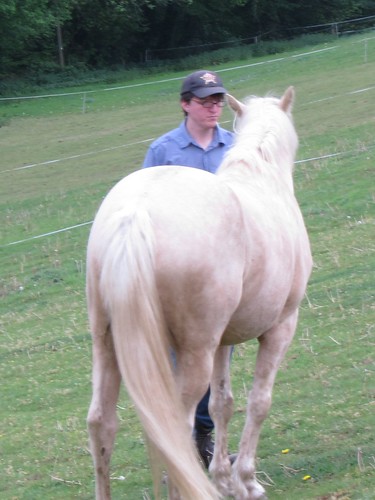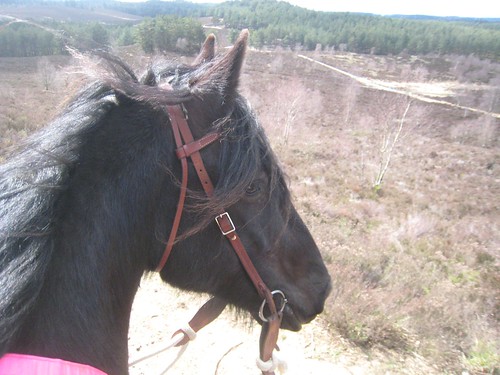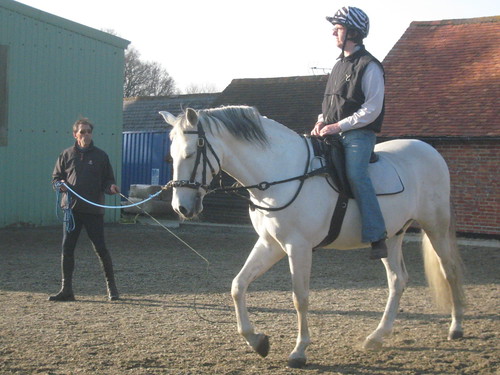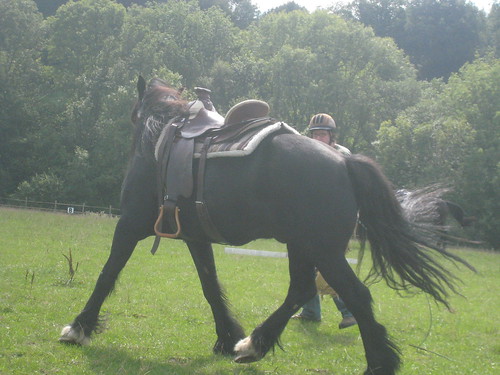I had done a few sessions with Cash before I bought him – that was how I knew I wanted to buy him – and I knew he could be a little unwilling to be caught. He was very ear shy and he was also worried about going through gates and being ridden, so there were a lot of reasons that he wasn’t keen to be caught. Consequently he wore a halter while he was out and he was usually caught using a scoop of mix and clipping on a rope when he went to eat it.
When he came to stay the first thing I did when I put him out was to take his halter off and let him loose to explore his new field for a while. Later in the day I came back with a halter and he allowed himself to be caught almost straight away. I was impressed, so I gave him a pony treat and let him go again. After a minute I went to catch him again. This time it took an hour and a half and I had to go through the whole process of teaching him to be caught. As you can imagine, I was very pleased I had decided to test that.

What I do with a horse who doesn’t want to be caught is to spend a while following them around. I don’t chase them, but as long as they want to walk away I follow them. If they want to stop I stop, if they give me an ear or look at me I step away. The moment their attention leaves me ( if they start grazing or looking at other horses or whatever ) I start approaching again. As I mentioned previously holding the horse’s attention is the starting point for any work you do with their mind.
After a while they figure out that they can approach me and I move off, which gives them some control over the situation- as far as the horse is concerned there is something going on that they have a part in, rather than me just trying to do something to them. Fairly soon the horse will start coming up to you to sniff you and investigate you at this point and be ready to accept you in their space.
How I progress depends a lot on why I think the horse is choosing not to be caught- as with many situation where a horse chooses not to do something, their decision making is on a continuum between “I have better things to do” and “I am afraid.” My aim is for them to be in the middle, where they are unafraid and want to spend time with me.
With a horse who doesn’t want to be caught because they don’t feel like it, I will tend to push them a little when they decide to move away from me- if they want to face me or approach me, I will back off and take off the pressure, but if they want to walk off then I will perhaps change things so they have to trot or canter instead. At the very least I want there to be no benefit in moving away, so I certainly need to make sure that they don’t get to eat or rest when they aren’t paying me attention. A consequence of this is that if you have a large field and you don’t want to spend a long time and get worn out, you might want to do this in a restricted area at first. You could also do it from the back of another horse, but if you’re placed to do that you probably don’t need my advice in the first place. Likewise it is easier to work on it if they aren’t out with a herd of other horses – you don’t need to do anything different if horses are around, but they are likely to get in the way, try to push the horse you are aiming to catch around and generally make the process take longer.
Cash was afraid, so I worked at the other extreme, trying to set things up so he didn’t feel that he needed to run away from me. I spent a lot of time on my approaches watching his balance and looking for him preparing to leave, then just waiting on that point so he didn’t have to. By this point I had his attention and he quite wanted to approach me so if he started to lean away or prepare to turn and I backed off a little he would often relax a little and maybe turn back towards me.
When he would stay still when I approached, I didn’t go straight for haltering him. I spent a while walking most of the way past him and just petting him on the rump then moving slowly forwards, rubbing on him. That gave him plenty of space to move if he needed me to and made my approach less threatening to him while also making my company pleasant. The first couple of times I did this, I walked away after I reached his shoulder to give him time to think over what had just happened.
Once I could stand at his shoulder I would rub on his neck and mane, still facing backwards and reaching under with my left hand to pass the halter up to my right hand without stopping rubbing on him. I was very careful and gentle with this and careful to avoid his ears as any contact with those bothered him. Whenever we made what seemed to me like a significant positive change I would give him a pony treat and walk away. I don’t hold a strong opinion on the use of treats with horses- sometimes with some horses it’s a good idea, other times with other horses it’s a bad one. If the horse is afraid and they’ll take the food then it is probably helpful as long as they are still able to give you their attention rather than obsessing on treats.
A few times during the process, especially as I got closer to having the halter on, Cash got concerned and had to leave but each time it was quicker to get back to where we had been and once he was caught and got treats and came in for his evening feed it was meaningful to him and it only took a few more sessions until I could walk up to him in the field and catch him. He’s still wary if you change anything, though – if I have his leather travelling halter rather than our regular rope halter he’s decidedly sceptical- but in general he’s now very happy to be caught.




